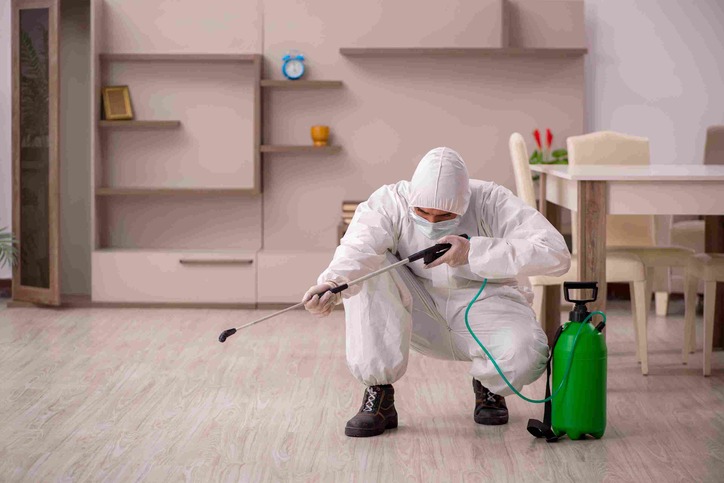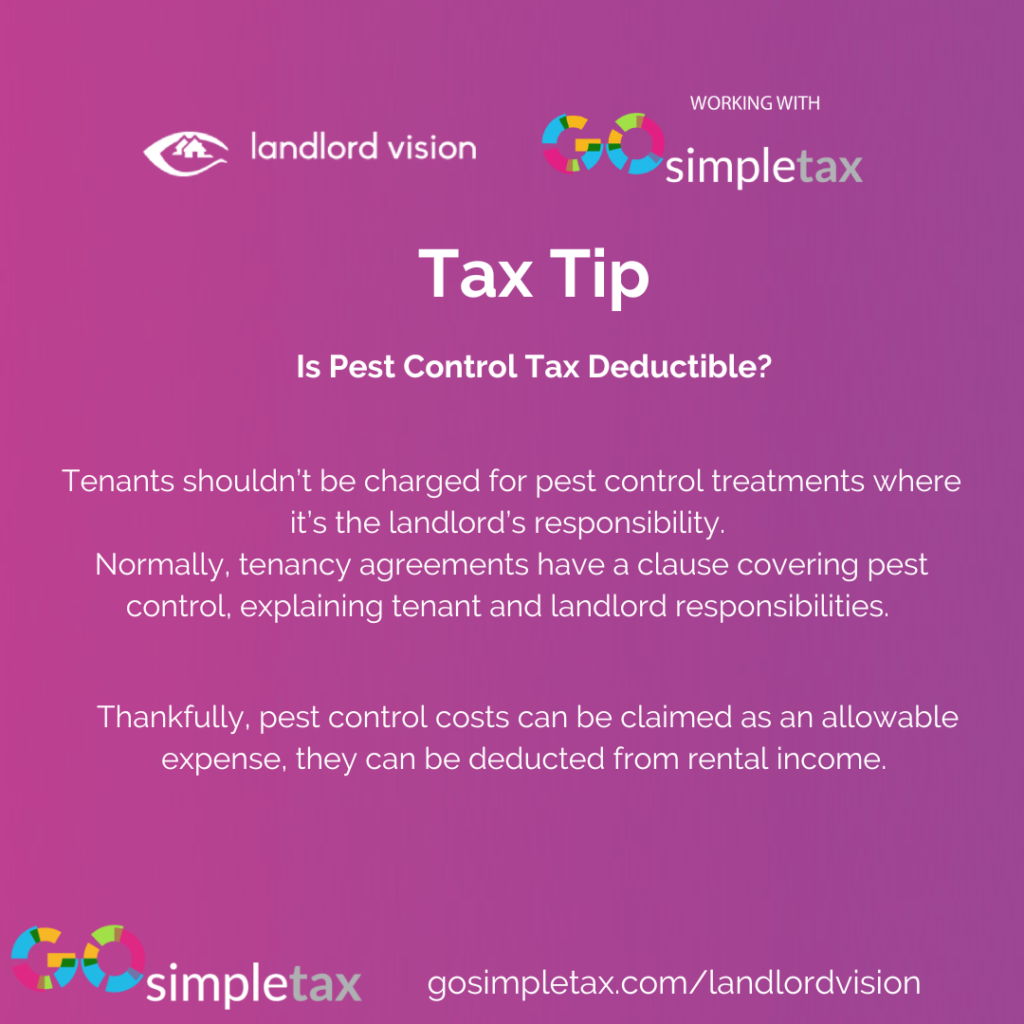
It’s one of those scenarios that landlords dread: an unexpected phone call, email or text from a tenant to deliver news of unwanted guests. Sometimes they’re furry; some have wings; while others are creepy and crawly. They can be really unpleasant and affect people’s health and happiness.
Domestic, residential or household pests come in many shapes and sizes, but doing nothing isn’t an option, as they usually don’t go away without some encouragement. So, what are the UK’s most common household pests and how do you get rid of them? Who is responsible for sorting out domestic pest issues and who pays the bill?
In this guest post by GoSimpleTax, find answers to these key questions and learn more essential facts about domestic pests and how to remove them.
The Importance of Pest Control
According to the British Pest Control Association (BPCA): “Pests [can]: contaminate homes and workplaces and spread disease; damage possessions and get into your foodstuffs; damage property, cause fires and flooding.” If there’s a pest problem in your rental property or own home, the BPCA says taking action is essential.
Although many household pests are pretty harmless, others potentially threaten human health. The BPCA explains: “Insects, rodents and birds can easily contaminate food and work surfaces with their excreta, hairs or body parts. These are potential pathogens that spread disease. Parasites carried by pest species can also be passed on to humans, causing illness and stress.”
Need to know! It can be an offence in the UK to disturb, damage, destroy or prevent access to a place a bird, animal, bat or insect uses for shelter or protection or breeding. And you can be fined or even imprisoned if you cause unnecessary harm to any animal.
Responsibility for Rental Property Pest Control
As explained on the Citizens Advice website (which is aimed at tenants): “Your landlord will probably be responsible for dealing with an infestation if:
- your tenancy agreement says they’re responsible – or it says they will keep your home in a ‘good and habitable state’
- the infestation was caused by your landlord not making certain repairs to your home, for example, not fixing holes in walls.
“Your landlord might also be responsible for dealing with an infestation if it means your home isn’t safe for you to live in, for example, if it’s making you or your family ill.”
Landlords are legally obliged to make sure that their properties are fit for human habitation, which includes eliminating household pests. On hearing from your tenant, you must arrange a visit from a pest control company or the local council within a “reasonable” amount of time. It’s in no one’s interest to allow the matter to drag on. While it’s not fair on tenants, leaving problems to worsen can ultimately increase costs significantly.
If you don’t act in a reasonable amount of time, a tenant can report you to the local council’s environmental health department and tell them that their health is being affected, and environmental health people can order landlords to sort out household pest problems. Ultimately, a tenant can take legal action against a landlord for not carrying out a repair or addressing a serious household pest infestation.
Need to know! Tenants are responsible for making sure their actions do not attract pests, for example, by leaving food or rubbish exposed outside so that it attracts foxes, rats, flies, etc. Landlords are not responsible for pest problems caused by a neighbouring property. Neighbours should be contacted immediately and asked to sort out issues for which they’re responsible
Common UK Household Pests – 6 of the Worst
1. Rats
Rats are the least-welcome domestic pests. They can carry many horrible diseases and spread them through their urine or bodies coming into contact with food and food-preparation surfaces. Rats can cause significant damage by gnawing through breeze blocks, wood, metal and wiring. Their presence is given away by droppings or the sound of their scurrying feet (normally in autumn and winter after dark).
Traps and poisons are used to remove rats, although they’re clever, wary creatures, so professional assistance is usually required. Professionals will try to exclude and trap before using poison, while a wide range of humane pest traps and other non-lethal solutions are available.
2. Mice
Mice may be cuter than rats, but most of us still don’t want them in our homes. Mice do not hibernate, so they can be a problem throughout the year. Via their urine and droppings, mice can spread Salmonella and Listeria to humans, which is why you don’t want them anywhere near where you store or prepare your food.
They too like to gnaw through electric wires, which can cause fires. To prevent problems with mice, try to identify and seal up potential entry points. This is no easy job because mice only need a gap of 6mm to gain entry. Using mouse traps and over-the-counter poisons may bring some success, but, again, professionals are more likely to end your rodent nightmare.
3. Ants
Ant infestations can be a serious problem during summer. They’re normally attracted by food, so advise your tenants to not leave any around. Entry points should also be sealed up, while some experts recommend mixing boric acid, sugar/syrup and hot water and leaving it near to the entrance to nearby ant nests. Ants feed on it and then transfer the poisonous mixture to the queen and other ants. Over-the-counter solutions are available in shops, but caution is advised with all poisonous substances. Natural ant repellents are believed to include cinnamon sticks, coffee grinds, chili pepper, paprika, cloves, lemon juice or dried peppermint left near to entry points.
4. Wasps
Problems with wasps are common in the warmer months and they can be severe if they’ve made a nest inside your property. Wasp stings are obviously very painful, but some people can experience a potentially life-threatening allergic reaction. Using a professional pest controller is advised. They’ll treat the entry to the wasp nest with a pesticide, which will do the trick within a few days. The nest can then be removed.
5. Cockroaches
Cockroaches carry Salmonella, Dysentery and Gastroenteritis, which pose significant health risks to humans. Reportedly, increases in eczema and asthma have been linked to cockroach droppings. According to pest controller Rentokil: “Cockroaches are tough insects and their ability to breed rapidly makes professional treatment essential to control infestation. Only expert products and solutions are powerful enough to eliminate all stages of their lifecycle.”
6. Bed Bugs
Bed bugs are flat, oval-shaped insects which are dark yellow, brown or red in colour. They feed on human and animal blood and adults are about 5 mm long. As explained on the NHS website: “Bed bugs hide on bed frames, mattresses, clothing, furniture, behind pictures and under loose wallpaper. Signs of bedbugs include: bites – often on skin exposed while sleeping, like the face, neck and arms; spots of blood on bedding – from the bites or from squashing a bedbug; small brown spots on bedding or furniture (bed bug poo).” Bed bug bites make skin feel itchy, but more serious health problems are uncommon. Because they’re hard to find and resistant to insecticides, getting rid of bed bugs really is a job for professionals.
Can Your Local Council Help?
It can be worth contacting the local council to find out about their pest-control services. They tend to have a call-out charge and an additional set price menu for various pest control solutions. Some councils don’t provide services for all household pests, in which case you’ll need to contact a pest-control company.
Finding a Pest Controller
You can visit the BPCA website to search for BPCA-approved pest controllers in your area. To be a BPCA member, companies must be regularly audited to the British Standard for pest management and have fully-qualified technicians. “You’ll get detailed pest prevention advice and a proper survey before [you get] a final quote,” says the BPCA.
Claim Tax Expenses for Household Pest Control
- Tenants shouldn’t be charged for pest control treatments where it’s the landlord’s responsibility. Normally, tenancy agreements have a clause covering pest control, explaining tenant and landlord responsibilities.
- Most tenancy agreements stipulate landlord responsibility for ensuring that the property remains habitable, but that the tenant is also responsible for keeping a property clean and for mitigating risk of pest infestation.
- Thankfully, all pest control costs can be claimed as an allowable expense, they can be deducted from rental income. You claim via Self Assessment by including pest control as an allowable expense within supplementary page SA105, which you file together with the main tax return, the SA100 to report income and other tax expenses and allowances.
- Retain proof of all pest control costs, because HMRC can ask to see proof after you’ve claimed them via your Self Assessment tax return.




